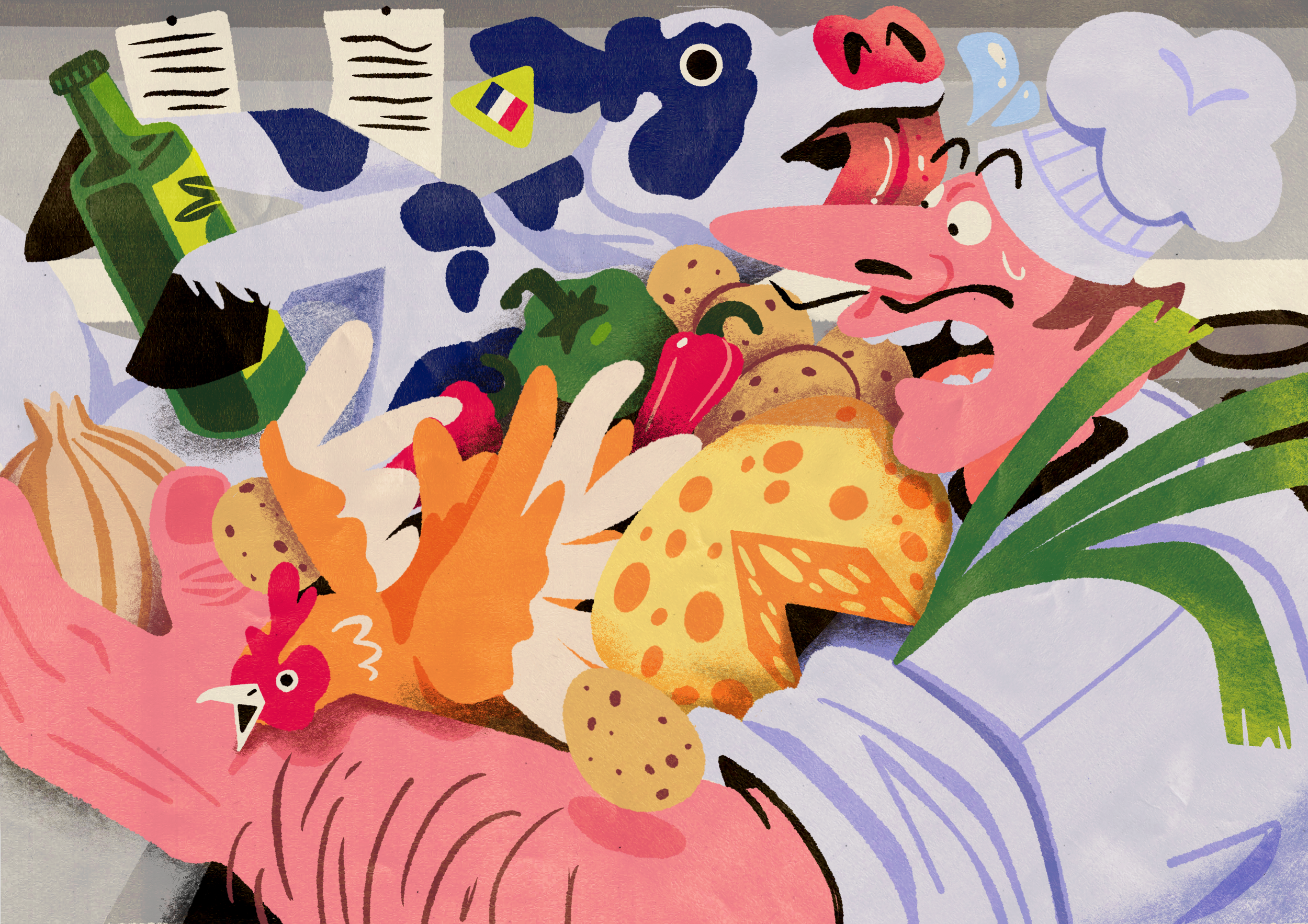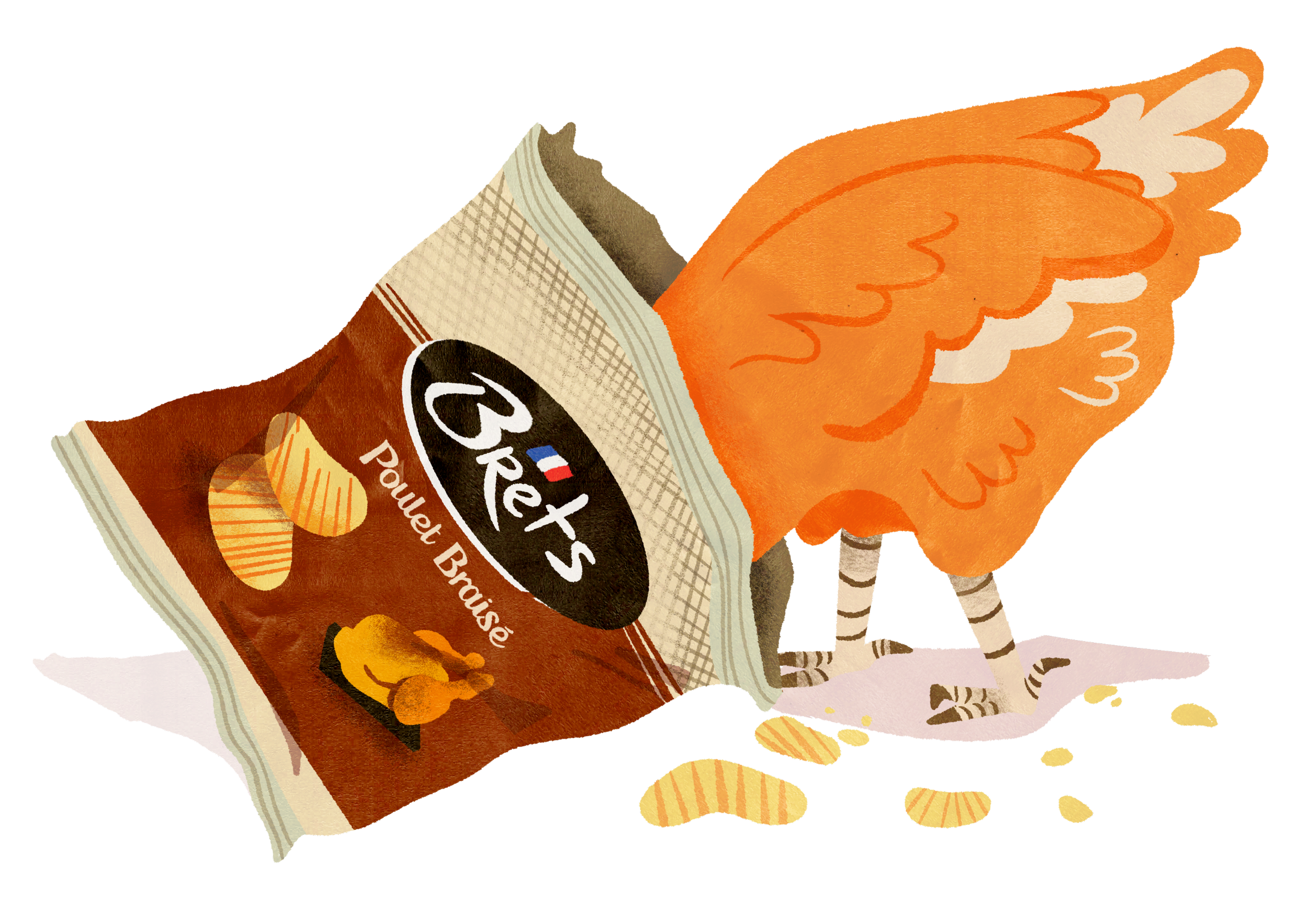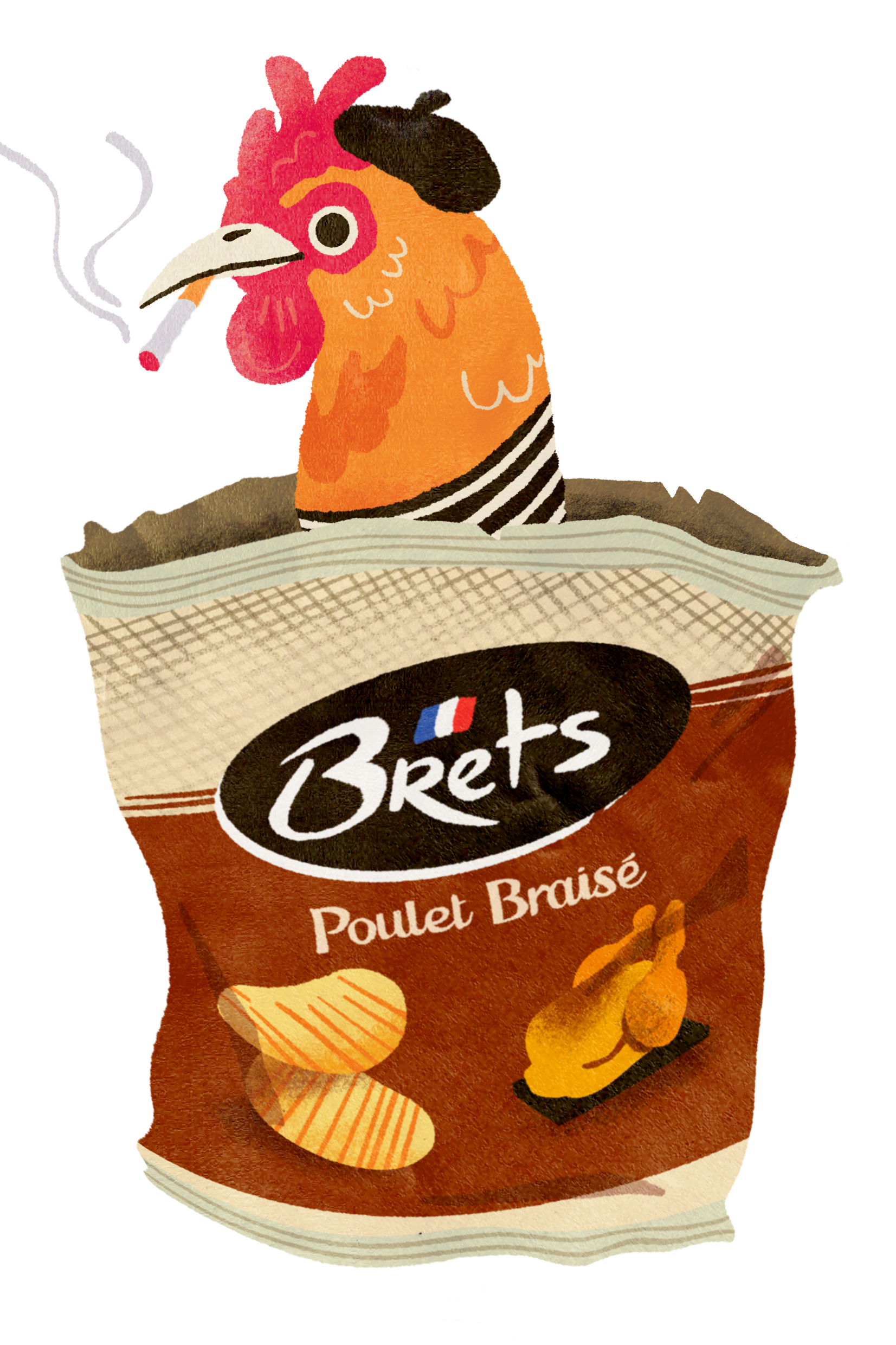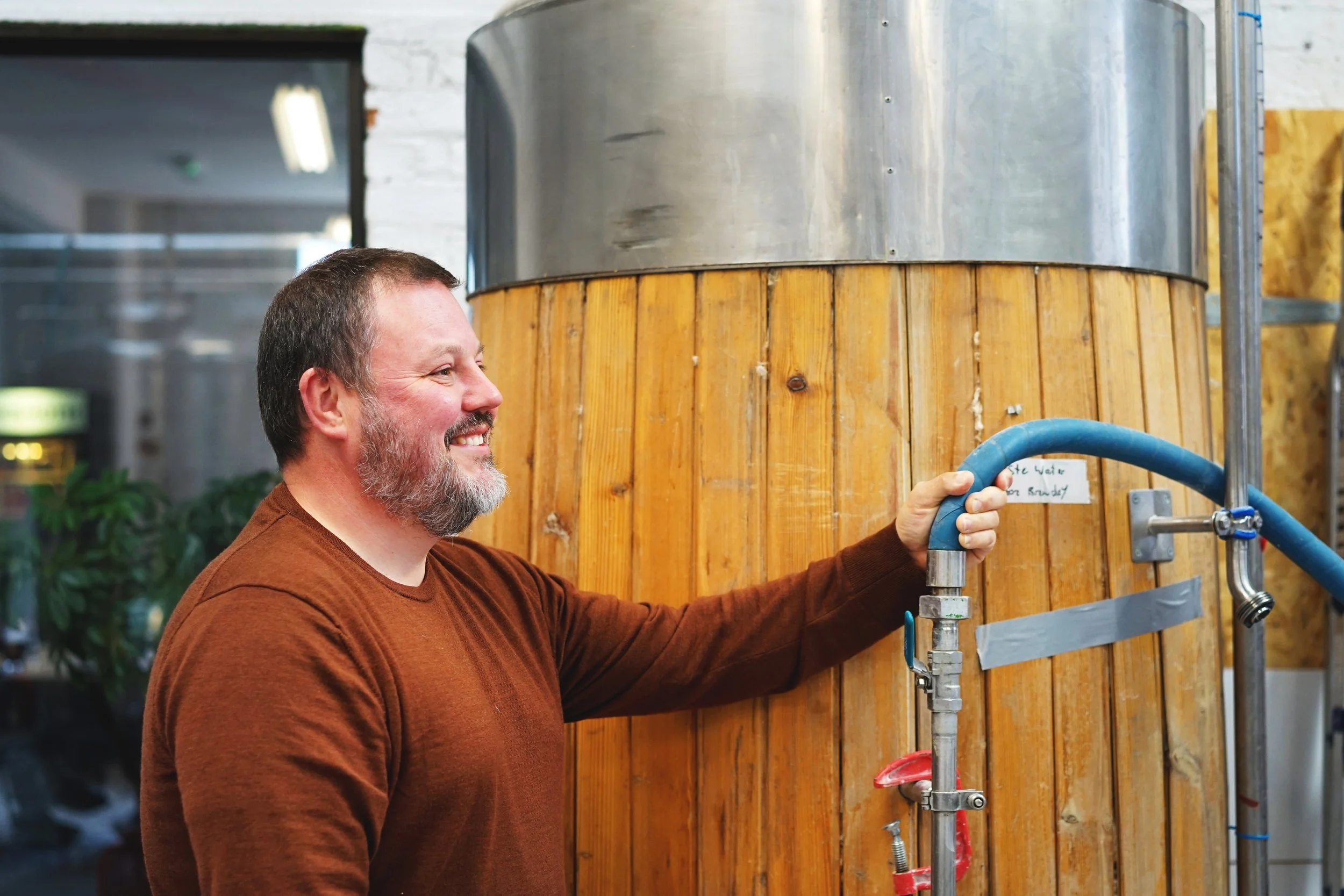It’s Not Chicken, It’s Braised Poulet — On Brets, the French Crisps Taking British Delis by Storm
They should be here but they aren't. This is the third place where I’ve tried to find them and failed. The packet of Brets beer and cheddar flavour crisps I’m searching for is nowhere to be found, and I frown at the thought of that cheesy, yet strangely bitter delicacy getting away from me. I surrender to the obvious by grabbing a pack of my favourite flavour, salted butter, instead, all for just €1.29 (£1.00.)
Brets isn’t even the prettiest crisp packet on the aisle. The packaging looks like what you might expect from a supermarket product: colorful and a bit tacky, with images of plated up food that could easily be from free image banks. It’s not ugly but it doesn’t have the “how nice” effect of UK brands like Tyrells that sit right next to it, with its elegant lettering and cool black and white pictures of very British people—but at €3.50 a bag (£3.00) I don’t even consider buying it.
Brets sits right in that sweet spot. It’s made by the Breton company, Altho-Brets, just 30 miles from where I live, so I can call it a local treat and forget that it’s a mass produced product. It always costs less than 2 euros (£1.68) depending on the flavour, and it’s also (most importantly of all) incredibly delicious.
I’m not the only one to think so. In thirty years, Brets has become the second largest crisp brand in France, with a striking progression in the last decade, going from a 3.5% market share in 2012, to more than 20% today. It’s creeping ever closer to Lay’s—the giant from PepsiCo known as Walkers in the UK—and its huge 26% market share.
The founder of Altho-Brets, well-known Breton businessman Alain Glon, has come a long way since growing up on the family farm. His parents were millers, producing flour, and struggling to feed their five kids. That’s until his father, André, got a business idea that would change everything after World War II: creating food blends for livestock.
This grew into a very lucrative affair—which was quickly passed on to Alain and his two brothers—and the Glon family made its wealth with livestock: feeding it, killing it, transforming it. This is as far from crisps as you can get.
Illustrations by Eilis Dart
But in 1991, profiting from his good relationship with farmers, Alain created an agricultural network for potato producers in Brittany. These potatoes were first sold to different crisp brands before Altho-Brets opened its own factory in 1995, launching at the same time the first French flavoured crisps, which mark the brand’s success to this day: braised chicken.
Alain is not just a crisps guy: his holding counts eleven companies, mainly located in Brittany, making crisps, frozen mochi and recycled packaging. Still family-owned—Laurent Cavard, Alain’s son-in-law, has been Altho-Brets’ CEO since 2009—the company went from sixteen people in its first operative year to 500 employees scattered between two production sites (in Brittany and in south eastern France), while a brand new one is getting built next to the historic factory.
***
When I pick up a Brets packet I wonder why I give it that much significance. Why is it this brand and not another? I don’t really think twice when I put pasta or crushed tomatoes in my shopping cart, but I spend a generous amount of time looking at the Brets range, selecting the perfect flavour while disregarding other brands entirely.
My first guess is an easy one: they’re damn good. As soon as I open the packet, I’m salivating from the salty buttery scent it delivers and wonder how they manage to get it so right.
Daniel Price thought the same the first time he tried Brets in London, and ultimately decided to stock it when he opened Two Sevens Deli in the Suffolk market town of Sudbury. “We have chicken and beef crisps here [in the UK], of course we do,” he says. “But there is something about Brets poulet braisé that tastes just like the crispy chicken skin, and it's amazing. Even the côte de bœuf has got a slight char to it, a sweetness and a savoury quality. It tastes like it should.”
If the chicken flavour actually tastes like chicken, a simple look at the ingredient list will tell you why: potatoes, sunflower oil, flavoring, salt, chicken meat powder.
““There is something about Brets poulet braisé that tastes just like the crispy chicken skin, and it’s amazing.””
Brets stopped using artificial aromas entirely in 2013, while the R&D department worked on a way to create the different flavours by actually crushing ingredients into a fine powder. This goes for all their flavoured crisps, like camembert and comté, which are essentially cheese reduced into said powder and sprinkled into the bag at the very last step of the production process.
But it’s not just about the thing tasting good or how it looks on the shelves—as I said, the packaging is not remarkable enough to rely on that. What first made Brets successful here in France is that it’s not just a crisps brand. It’s not even a French crisps brand: it’s a Breton one, and it matters.
[Editor’s Note: Despite numerous requests, Altho-Brets did not respond to our writer’s request for comment on this feature.]
***
Brets is short for Bretagne (Brittany), which also sounds like Breizh (Brittany in Breton). If you enter a supermarket in the region, this type of branding will be everywhere to see. Breizh Cola in place of the well-known American soda, CaraBreizh for a salted caramel treat, or NutaBreizh, the local take of the famous chocolate spread, without the palm oil.
“The agro-industry see the regionalisation of their brand as a symbolic and narrative resource. Anchoring themselves in a specific area guarantees a form of authenticity and tradition to the consumer,” says Clémentine Hugol-Gential, professor and researcher specialised in food marketing. “Geographical origin is a way to tell a story and for consumers, who like to see the promotion of their region, it conveys the idea of proximity, sustainability, ethics.”
It wasn’t always like this. Breizh, Bretagne or Breton weren’t always marketable words to associate your brand with. After WWII, Breizh was a very negative word to use and not many people were claiming their Breton pride, in fear of being called a “Breiz Atao”, a name to designate the Breton autonomists who collaborated with the Nazis.
Before Brittany became a trendy spot for rich people’s vacation homes, Breton people were seen as peasants or, as we say in French, plouc. The word itself is derived from the Breton word “plou” (parish), seen in many town names in the region: Plougoumelen, Plouhinec, Plouharnel, Plouyé etc. Now though, since the Breton revival that started in the 1980s with the influence of cultural institutions, politicians and local entrepreneurs like Alain—who is part of several Breton lobbies—Brittany is in and so are their products.
When I buy Brets crisps, I feel like I’m supporting the region I live in. In a way, this is true, because the brand works with 341 French potato producers and employs hundreds of people in the area. “When something is produced regionally, close to us, we feel like we know where it really comes from,” Clémentine says. “Traceability would mean that that specific product is better than another one.”
But Brets is also tailored to be massively produced: Altho-Brets makes 45,000 tons of crisps each year, which represent 180,000 tons of potatoes. Potato cultivation is soil intensive and requires greedy volumes of water, a process that has been disputed for its use of pesticides, monopolization of water resources and weakening agricultural land. When the new factory is in place, Brets will have a water consumption increase of 100,000 m³ each year, in a region already facing major drought problems due to an intensive breeding industry and agriculture. Am I really supporting the place I live in by buying these crisps?
***
Brets used to go harder on the Breton references. In 2019, the black and white packaging referring to the Breton flag (the Gwenn ha du) was replaced by a small French flag, and the Breton translation disappeared, with the need to be more recognised nationally and globally.
The brand got attention thanks to very well-identified Breton flavours like salted butter, Roscoff onion and buckwheat, but also with ones inspired by French food (and even drink) culture: camembert, comté, Pastis, côte de bœuf, tartiflette. Now they’ve been dipping their toes in global flavours such as falafel, kebab, and yakitori. And it works.
When Brets released eight new flavours in March 2025 (including the beer and cheddar one I can’t put my hands on,) the marketing team didn’t need to spread the word about it. Putting it on shelves was enough to lead to hundreds of tasting videos all over the internet.
““Crisps are made to be eaten straight out of the bag on the side of the road during a trip. Crisps need to be put in a big plastic bowl while sausages grill on the barbecue.””
Clémentine believes Brets has become somewhat part of pop culture: “Their clients are ambassadors, with a very high level of loyalty,” she says. “The brand managed to give an exotic feeling to a regional and familiar taste and changed the way people see and eat crisps by giving it value. Now you don’t just open crisps packets, you open a product, you talk about the flavour you chose and why you chose it.”
This has made Brets a trendsetter in the crisp world: in Spring 2024, Vico (produced in France but owned by the German company Intersnack) released their street-food range with Thai beef and cheese naan flavoured crisps.
Daniel has seen the same level of loyalty from his customers: “When the chip shop curry sauce ones came and I put them on my Instagram, I sold out of them in three days,” he says. “People come to us from all over because someone will tell them that we stock Brets. They've just become really part of what we are.”
When Brets crossed the English Channel, it lost its regional aspect to the consumer eye. But being a French crisps brand abroad gave it a whole new perspective: Brets got fancier—at Two Sevens Deli, Daniel sells them for £4 a pack.
“When people are sitting down with a glass of something nice in my shop, if I said to them, here's some Quavers, they'd be like, why are you serving me Quavers,” Daniel says laughing. “But if you say, these are Comté flavoured crisps from France, they go, ‘Oh’ right?”
As much as I love crisps, it would not cross my mind to order it as I sip a glass of wine at a posh place in France—they won’t sell them there anyway. Crisps are made to be eaten straight out of the bag on the side of the road during a trip. Crisps need to be put in a big plastic bowl while sausages grill on the barbecue. Crisps always wait for you after a sporty day at the beach, when hunger wakes up your stomach and gets you out of the water. In my mind, crisps are convenient, easy, accessible. Never fancy.
But at Two Sevens Deli, that’s exactly their purpose: getting that feeling of having something special that only an imported good manages to convey—a feeling amplified by the fact Brets is not massively distributed in the UK yet. All of that thanks to France’s intensive lobbying to make its food look more refined than any other one globally, whether this is true or not.
“I think they [my customers] see them as more than just a crisp. They're a bit more sophisticated because they're not just chicken, they're braised poulet,” Daniel says. “There are a lot of people out there that like the idea that they're buying a big bag of crisps, but they're not just a big bag of crisps, they’re from France.”













